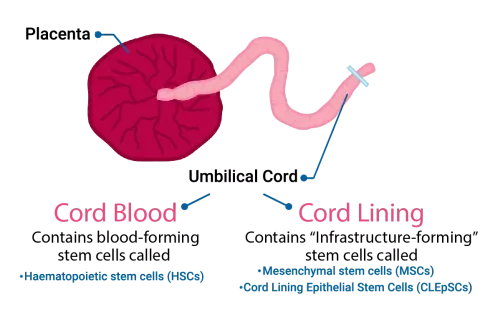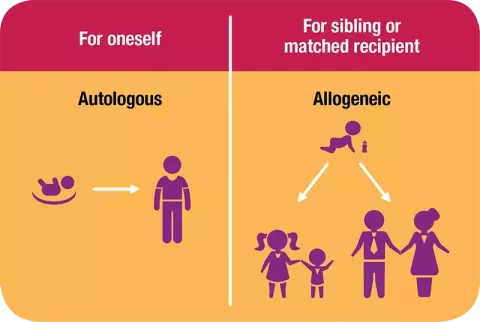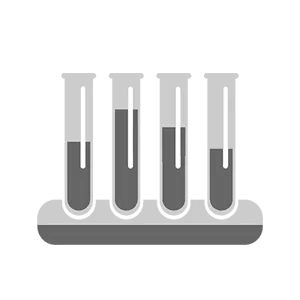
Don't settle for less
for your baby
Instead of basic cord tissue, save your baby's cord lining, which has two types of cells, to provide extra protection for your family.
What makes your baby’s umbilical cord lining unique?
From medical waste to a valuable resource containing potentially lifesaving stem cells.
Historically, the umbilical cord has been regarded as medical waste and commonly disposed of with the placenta after a baby's birth. Yet, various studies have revealed its significant medical potential.
The umbilical cord contains cord blood, Wharton’s jelly, and other components, and it’s protected by a sheet-like membrane called the cord lining.
Wharton’s jelly contains only one type of stem cells (mesenchymal stem cells), while the cord lining comprises two types—mesenchymal stem cells and cord lining epithelial stem cells.

Immense potential to repair and heal our body
Mesenchymal stem cells (MSCs) and Cord Lining Epithelial Stem Cells (CLEpSCs) have the potential to repair and heal the body in ways that cord blood does not.
These cells have shown their potential in healing damaged tissues and organs, as well as treating a number of diseases.
Mesenchymal Stem Cells
Mesenchymal Stem Cells have the ability to self-renew and differentiate into:
- Bone cells
- Cartilage cells
- Heart cells
- Muscle cells
- Nerve cells
- Pancreatic cells
- Fat cells
Cord Lining Epithelial Stem Cells
Cord Lining Epithelial Stem Cells are multipotent cells with the ability to differentiate into:
- Pancreatogenic cells
- Keratogenic cells
- Corneal cells
- Hepatocyte-like cells
Conditions in clinical trials
The table below lists some of the conditions that are currently being researched or have previously been studied in clinical trials using mesenchymal stem cells or umbilical cord lining-derived epithelial cells as interventions. As clinical research continues to take place around the world, some of these trials may advance to become the new standard of care for these conditions. Please visit clinicaltrials.gov for the complete list.
Mesenchymal Stem Cell trials
TISSUE REPAIR
- Stroke
- Heart failure
- Alzheimer’s disease
- Parkinson’s disease
- Spinal cord injury
- Orthopaedic indications (bone, cartilage, tendon repair)
- Liver failure
NEUROLOGICAL & DEVELOPMENTAL
AUTOIMMUNE OR IMMUNE MODULATION
TRANSPLANTATION SUPPORT
- Shorten engraftment time of blood-forming cells
- Reduce immune system complications
OTHERS
Cord Lining Epithelial Stem Cell trials
SOFT TISSUE REPAIR
- Skin wounds
- Ocular surface disorders
- Persistent epithelial defect
- Replacement of insulin-producing cells for diabetic patients
- Haemophilia
OTHERS
Who can use your baby’s cord lining?
Your baby’s cord lining stem cells could potentially be used on your entire family because they have immune-modulating properties that make them immune-privileged. Over the last decade, more than 55,000 publications on MSCs have been published, demonstrating their unique properties.1
1.Pittenger MF, Discher D, Péault BM, Phinney DG, Mesenchymal stem cell perspective: cell biology to clinical progress. Regen. Med. 2019;4(1):22.

Advantages of cord lining stem cells
Even though Cord Lining Epithelial Stem Cells and Mesenchymal Stem Cells can be derived from other sources, the table below shows some of the many benefits of using cells from the cord lining.
| Parameter | Cord lining | Basic Cord Tissue Wharton's Jelly | Placenta | Bone marrow | Fat |
| Ease of collection | ✓ | ✓ | ✓ | ✗ | ✗ |
| Ease of processing | ✓ | ✓ | ✗ | ✗ | ✗ |
| High yield | ✓ | ✗ | ✗ | ✗ | ✗ |
| Mesenchymal stem cell population | ✓ | ✓ | ✓ | ✓ | ✓ |
| Epithelial cell population | ✓ | ✗ | ✓ | ✗ | ✗ |
| Age of stem cells | Infant | Infant | Mixed (comprise of cells from mother and child) | Adult | Adult |
| Presence of immune modulating markers | ✓ | ✓ | ✓ | ✗ | ✗ |
More reasons to consider cord lining banking

Once-in-a-lifetime opportunity
Your baby's cord lining must be collected at birth. The opportunity to preserve it will be lost forever if it is missed.

Readily Available
Cryogenic storage will keep your baby's cord lining safe for a long time, so you can retrieve it for transplants whenever necessary.

Preserved in original form
We keep your baby's cord lining in its original form so that you can use newer technologies to obtain more cells in the future.




